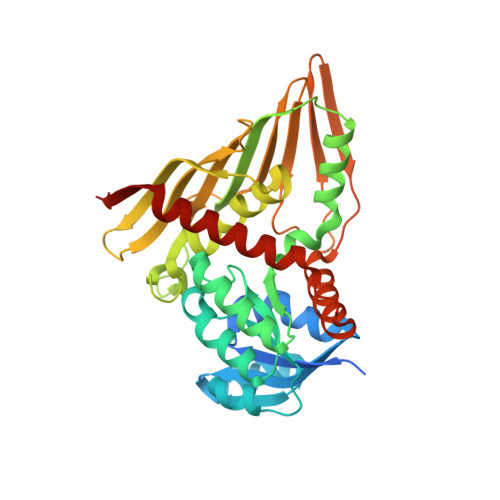Combined Structural and Functional Investigation of a C-3''-Ketoreductase Involved in the Biosynthesis of dTDP-l-Digitoxose.
Kubiak, R.L., Holden, H.M.(2011) Biochemistry 50: 5905-5917
- PubMed: 21598943
- DOI: https://doi.org/10.1021/bi200514b
- Primary Citation of Related Structures:
3RBV, 3RC1, 3RC2, 3RC7, 3RC9, 3RCB - PubMed Abstract:
l-Digitoxose is an unusual dideoxysugar found attached to various pharmacologically active natural products, including the antitumor antibiotic tetrocarcin A and the antibiotics kijanimicin and jadomycin B. Six enzymes are required for its production starting from glucose 1-phosphate. Here we describe a combined structural and functional investigation of KijD10, an NADPH-dependent C-3''-ketoreductase that catalyzes the third step of l-digitoxose biosynthesis in the African soil-dwelling bacterium Actinomadura kijaniata. KijD10 belongs to the glucose-fructose oxidoreductase superfamily. For this investigation, both binary and ternary complexes of KijD10 were crystallized, and their structures were determined to 2.0 ? resolution or better. On the basis of these high-resolution structures, two potential active site acids were identified, Lys 102 and Tyr 186. These residues were individually mutated and the resultant proteins investigated both kinetically and structurally. The Y186F mutant protein demonstrated significant catalytic activity, and its structure was virtually identical to that of the wild-type enzyme except for the positioning of the nicotinamide ring. All lysine mutations, on the other hand, resulted in proteins with either abolished or drastically reduced catalytic activities. Structures for the K102A and K102E mutant proteins were determined and showed that the abrogation of catalytic activity was not a result of large conformational changes. Taken together, these data suggest that Lys 102 donates a proton to the C-3'' keto group during the reaction and that Tyr 186 serves only an auxiliary role. This is in contrast to that proposed for glucose-fructose oxidoreductase and other family members in which the tyrosines, or in some cases similarly positioned histidines, are thought to play major catalytic roles.
Organizational Affiliation:
Department of Biochemistry, University of Wisconsin, Madison, Wisconsin 53706, United States.



















